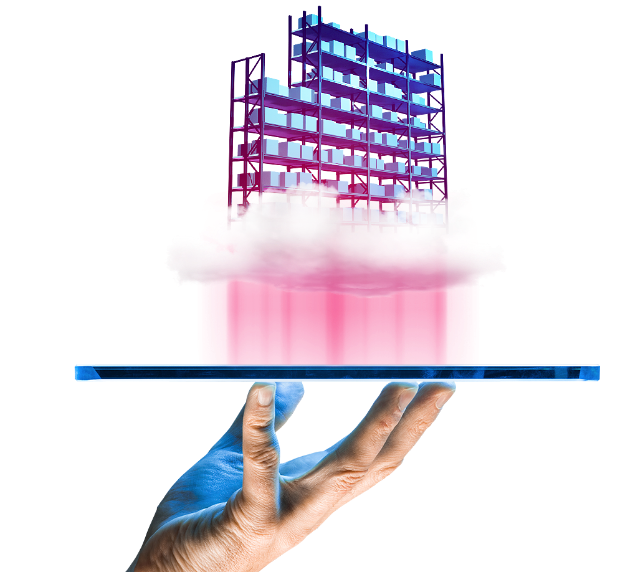- Home
- Knowledge center
- Blog
- What is saas wms/cloud wms and why go for it?
Blog
WHAT IS SAAS WMS/CLOUD WMS AND WHY GO FOR IT?
With easy, secure access to computing power and high-speed internet, a growing number of companies choose a cloud-based warehouse management system (WMS) to streamline their logistics processes. In this blog post, we check what a SaaS WMS is and its advantages over traditional, on-premises WMS installations.
So, what is SaaS WMS?
SaaS WMS means operating your warehouse management system (WMS) in a software-as-a-service (SaaS) model. Instead of running the system on-premises on your own servers, it is hosted in the cloud (hence the term “cloud-based”). You can access the application over the Internet and pay a monthly subscription fee for the service to your software provider.

Why should I go for a SaaS warehouse management system?
Choosing a WMS SaaS solution over on-premises installation can have many benefits. Here are the top 5 reasons to consider:
1. Much lower entry threshold and elimination of licensing costs and server requirements
Opting for a high-quality cloud-based WMS can significantly lower your initial investment required to implement a robust warehouse management system. You can have the same functionality as in the on-premises version but without the need for expensive licenses or dedicated servers. This also means the solution is available to a wider range of companies, including those without extensive IT resources.
With SaaS, you can eliminate capital expenditures (CAPEX) associated with server infrastructure, database software, and operating systems. Moreover, most of the remaining costs are spread over time and become apparent when the system has already started generating the first savings.
2. Faster return on investment compared to traditional license models
Choosing SaaS WMS software enables a significant shift from capital to operational expenses (OPEX), positively impacting your cash flow.
In terms of total costs of ownership (TCO) analysis, comparing the SaaS model with traditional licenses and local installation on a physical server is particularly interesting:
SaaS costs:
- Implementation
- Monthly subscription multiplied by the number of months
On-premises costs:
- Implementation
- Software licenses
- Maintenance fee
- Costs related to setting up the IT infrastructure (e.g., servers, database software, operating systems, IT services)
When comparing these costs over time, there is a turning point where SaaS may become "more expensive" than the traditional installation. However, if this point is between 3 and 5 years, then, considering the other benefits, a cloud-based WMS becomes the better investment in the long term.
3. Scalability to meet your ever-changing business needs
One of the undeniable advantages of SaaS WMS solutions is scalability. Think of seasonal fluctuations which directly impact the workforce capacity required in your warehouse. In certain industries, the difference between the number of employees during peak season and off-season can be quite high, sometimes reaching several hundred percent. Purchasing perpetual licenses for seasonal workers may prove to be a significant financial burden, potentially jeopardizing the return on investment for the entire enterprise.
With a SaaS WMS model, you only pay for the number of users and computing power required at any given time. This eliminates the risk of overinvesting in licenses that may become unnecessary after implementation and during system operation. Additionally, as the goal of investing in a new WMS often includes reducing the number of warehouse employees, a cloud-based WMS solution allows you to access the necessary computing power on-demand without the need to maintain infrastructure solely for high-season requirements throughout the year.
4. Single-supplier responsibility for system operation
In an on-premises installation scenario, diagnosing and resolving failures often involves identifying whether the problem lies within the WMS, the database, server software, or other elements of the IT infrastructure. In contrast, a SaaS warehouse management system provides a single point of contact—your WMS supplier—who assumes full responsibility for the entire system's operation. This streamlined approach offers enhanced service level agreements (SLAs) compared to on-premises installations, ensuring more reliable and efficient system performance.
5. You have seamless access to new versions as part of the subscription
Users of IT systems around the globe face a common challenge – aging software. Many vendors already offer software upgrades for an additional license fee or as part of the maintenance fee (typically a percentage of the purchased licenses). However, if your WMS is customized to your specific needs, it can make upgrades more complex. While larger vendors can ensure compatibility of your specific functionalities with new system versions, less mature systems often require a new implementation.
In the case of a cloud-based WMS (cloud-based warehouse management system), upgrades are automatic background processes, which means you'll always be working on the latest version by default.
Are you exploring WMS SaaS options?
Our WMS warehouse system, Astro WMS®, is designed to support your long-term needs: it is scalable, rich in configurable core features and functionality, and adaptable across multiple sites. In addition, it can easily be integrated with any supplier’s automation equipment, giving you the freedom to choose when implementing a warehouse automation solution.
FAQs
What is a SaaS WMS?
A Software-as-a-Service Warehouse Management System (SaaS WMS) is a cloud-based solution for managing warehouse operations. Instead of running the system on on-premises servers, it is hosted in the cloud, allowing businesses to access it via the internet and pay through a subscription model.
How does SaaS WMS differ from traditional WMS?
Unlike on-premises WMS solutions that require on-site servers and significant upfront investments, SaaS WMS offers a lower entry threshold by eliminating expensive licenses and infrastructure needs. It also provides automatic updates, scalability, and easier integration with other systems.
What are the benefits of using a SaaS WMS?
How does SaaS WMS improve warehouse efficiency?
SaaS WMS eliminates system downtime associated with on-premises maintenance while offering the same workflow optimization and real-time data visibility as traditional solutions. This reduces disruptions and supports consistent operations, helping improve efficiency and productivity over time.
What costs are associated with SaaS WMS?
The costs typically include a monthly or annual subscription fee based on the number of users or level of functionality required. This model spreads expenses over time, making it more predictable compared to the upfront costs of traditional WMS.
Is SaaS WMS secure?
Yes, SaaS WMS providers ensure robust security measures, such as data encryption, frequent backups, and compliance with industry standards, to protect your data in the cloud.
